Striped Bass from the Fort Point Pier
Temperate Sea Basses: Family Percichthyidae
Species: Morone saxatilis (Walbaum, 1792); from Morone (a word of unknown origin attributed to Samuel Latham Mitchell who named it in 1814) and the Latin saxatilis (to live among rocks). CA Fish Bulletin #28 (1930) uses the name Roccus lineatus. CA Fish Bulletin #157 (1972) uses Roccus saxatilis. Although a bass, stripers are placed in the “temperate bass” family Moronidae instead of the “sea bass” family Serranidae, which is home to most of California’s saltwater bass.
Alternate Names: Striper, linesider, rock bass, rock fish, streaked bass and my favorites—squidhound or “rock.” Called lubina estriada in Mexico.
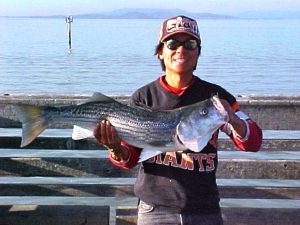
Striped bass caught by Stan at the Point Pinole Pier in 2003
Range: From 25 miles south of the California-Mexico border to Barkley Sound in British Columbia. Common in San Francisco Bay and central California to Monterey; occasionally seen at southern California piers.
Habitat: An anadromous species that moves from freshwater to saltwater and back. Typically found in shallow-water areas, both sandy and rocky. Recorded to a depth of 180 feet.
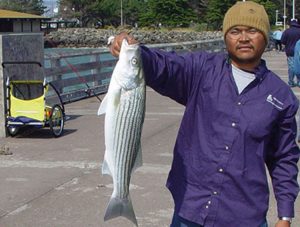
Striped Bass from the Berkeley Pier in 2003
Identification: Typical bass shape with two dorsal fins. Brownish, copper, or steel bluish with brassy reflections; more silverish on the sides; seven or eight blackish, horizontal stripes on the side of the body.
Size: Up to 4 feet and 90 pounds in California. Most striped bass caught off piers are the smaller schooling stripers under five pounds in size. Each year will see a few lucky anglers catching large fish—some up to 40-50 pounds. The IGFA World Record fish is listed at 81 Lbs 14 oz and was caught in Long Island Sound, Westbrook, Connecticut in 2011.
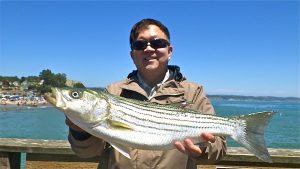
Striped Bass from the Capitola Wharf in 2016
Piers: Really only common at Bay Area and Delta piers. Given their anadromous nature, most California stripers spend the winter months in the fresh water of the Sacramento-San Joaquin Delta; they then move down to salt water in the spring, spend the warm months in the bay or adjacent ocean areas, and return upstream again in the fall. Spring and fall see catches of stripers at piers on both the west and east sides of San Pablo Bay as the fish head toward the Golden Gate. Summer is the prime time for piers throughout San Francisco Bay as well as areas out to Pacifica Pier (and down to Monterey Bay). Best bets depend on the season. During the mid-to-late summer, I would try Pacifica Pier or any pier along the western side of San Francisco Bay. During the spring, I would try the Point Pinole Pier. During the fall, they mainly hit Marin County piers (the World Series bite in October is famous) and piers near the Carquinez Strait area including the Eckley Pier and Martinez Pier. Fall is a prime time to try the various piers in the Pittsburg and Antioch area for the larger stripers that are passing through. Almost all of the piers in the Antioch area (but especially the Antioch Bridge Pier) out to the Rio Vista and Isleton piers seem to yield an unending number of small (mostly illegal) stripers from spring to fall. Quite a few are also caught during the summer from the Capitola Wharf.
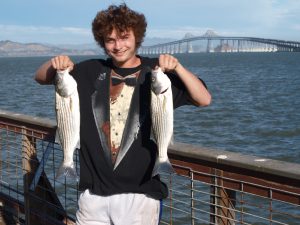
Striped Bass caught from the Marin Rod & Gun Club Pier by Preston in 2013
Shoreline: One of the main goals for shore anglers in the San Francisco Bay-Delta. For many years the beaches south of San Francisco were considered the top striper areas in the West.
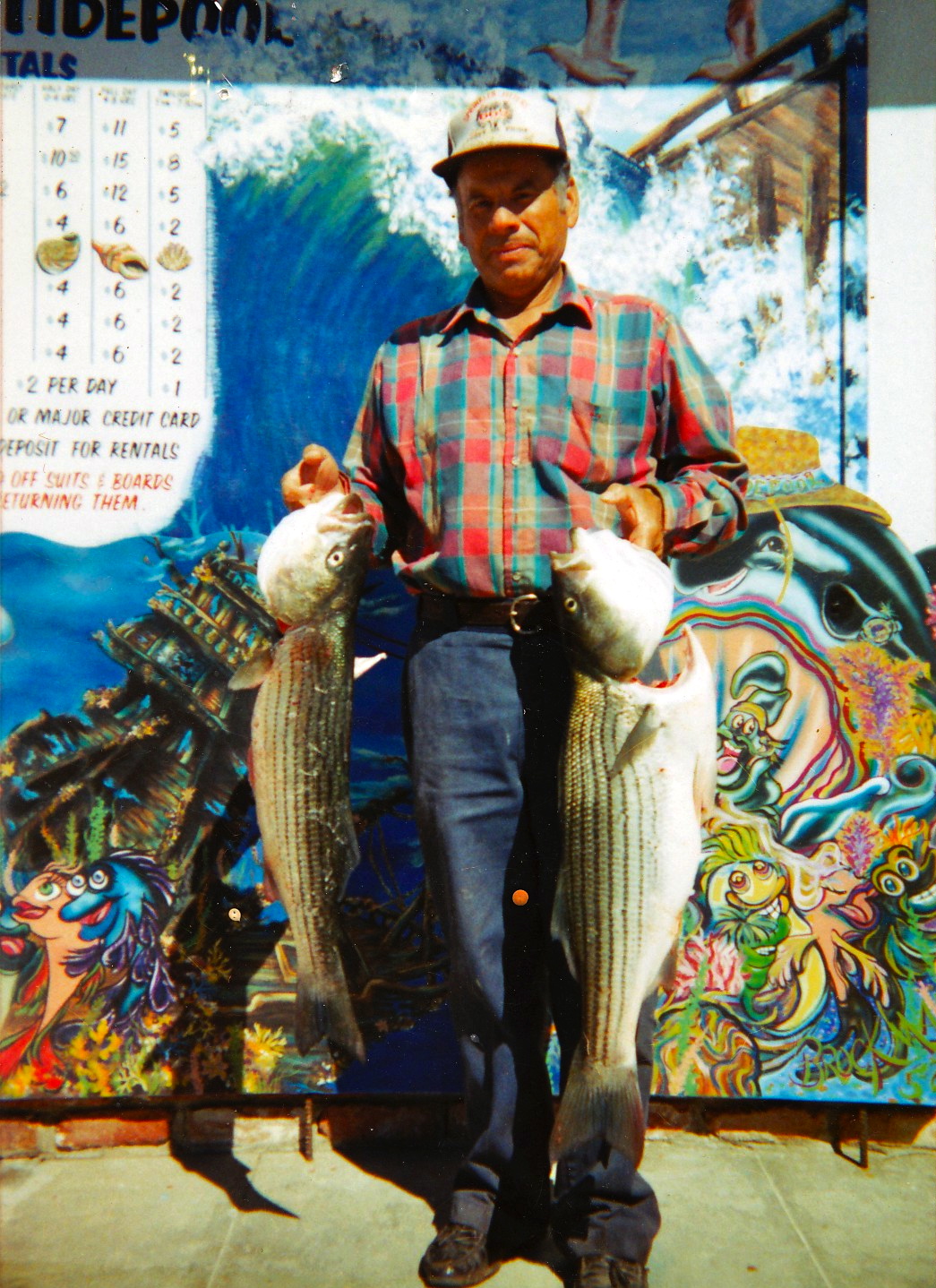
Two stripers taken from the Cayucos Pier
Boats: One of the main species sought out in the San Francisco Bay-Delta. Both live bait and lures attract striped bass.
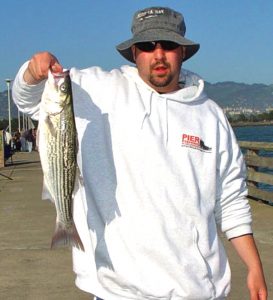
Striper caught at the Berkeley Pier in 2003
Bait and Tackle: The main idea here is to have heavy enough tackle that you can fight the unexpected big fish. Although most of the fish you catch will be less than 10 pounds, be prepared for the 30-pounder. Tackle should be medium size, line should be at least 25-pound test, and hooks may vary from size 2 to 2/0. Best baits are live small fish such as shinerperch, staghorn sculpin (bullheads), other small sculpins, or live shrimp. Cut bait including sardines, anchovies and even mackerel will often work as well. Stripers will also hit worms, but worms are used mostly for the smaller fish. Several regulars have mentioned that dead “bullheads” are also very effective as long as they still retain the slime on their skin. Although artificials can be deadly in a boat and on shore, they are used less frequently on the piers and tend to be less effective. To avoid the small stripers at the Antioch piers you need to use larger baits and regulars tell me that live bluegills and Sacramento squawfish fit the bill.
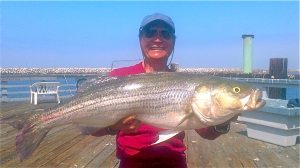
Striper caught at the Redondo Sportfishing Pier in 2012
Food Value: Striper fillets have a mild flavor with small flakes and somewhat soft texture. The meat is white in color and moderate in fat content. It is delicious almost any way you prepare it. However, the flesh of larger fish (above about 12 pounds in size) tends to become coarse (softer or looser in texture) and becomes less flavorsome with age. In addition, if taken from piers in the Bay Area, the flesh will tend to have toxins so cooking methods that help remove toxins from the flesh, i.e., broiling, are recommended.
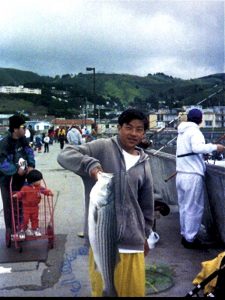
Striper caught at the Pacifica Pier by Matt Shockley in 1998
Comments: Striped Bass were introduced from the Atlantic Ocean in 1879; the first fish were released in the Carquinez Straits near Martinez. For many years striped bass were the most sought after fish in San Francisco Bay; today they share that honor with white sturgeon and California halibut. Although still an uncommon catch from southern California piers, they have been planted in San Diego, Mission, Newport and Anaheim bays since 1974 and most years will see some stripers taken from piers, the surf, and bays in southern California. Recently several have been taken from the Torrey Pines area in San Diego County.
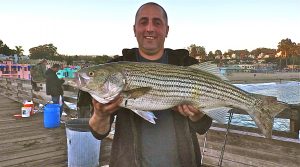
Striped Bass caught by Mark Spencer from the Capitola Wharf in 2016
History Note: Livingstone Stone, Deputy Fish Commissioner, has arrived with a [box] car load of fish and spawn for California waters. The consignment comprises 1,000,000 lobster eggs, a large quantity of rock fish known in the East as striped bass, and a lot of black bass. The striped bass are to be placed in the Sacramento river at Martinez. The black bass will be placed in a private pond and the lobster eggs will be taken to the neighborhood of Duxbury Reef which lies outside the Heads, almost opposite Bolinas Bay. — The Fresno Republican, June 28, 1879
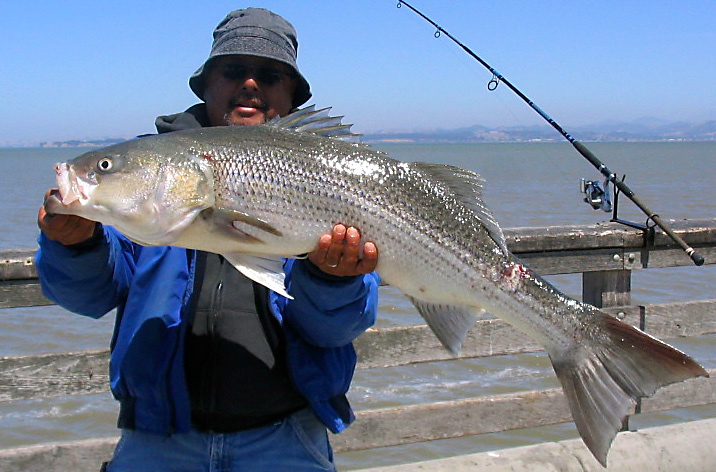
Large striped bass taken at the McNear Pier in San Rafael by Mel in 2006
The 3,000 striped bass put in Carquinez Straits a year ago by the California Fish Commissioners have been heard from. One was caught on Monday between Sausalito and Alcatrez, measuring twelve and a half inches in length and weighing nearly a pound. —The Sacramento Record-Union, June 15, 1880
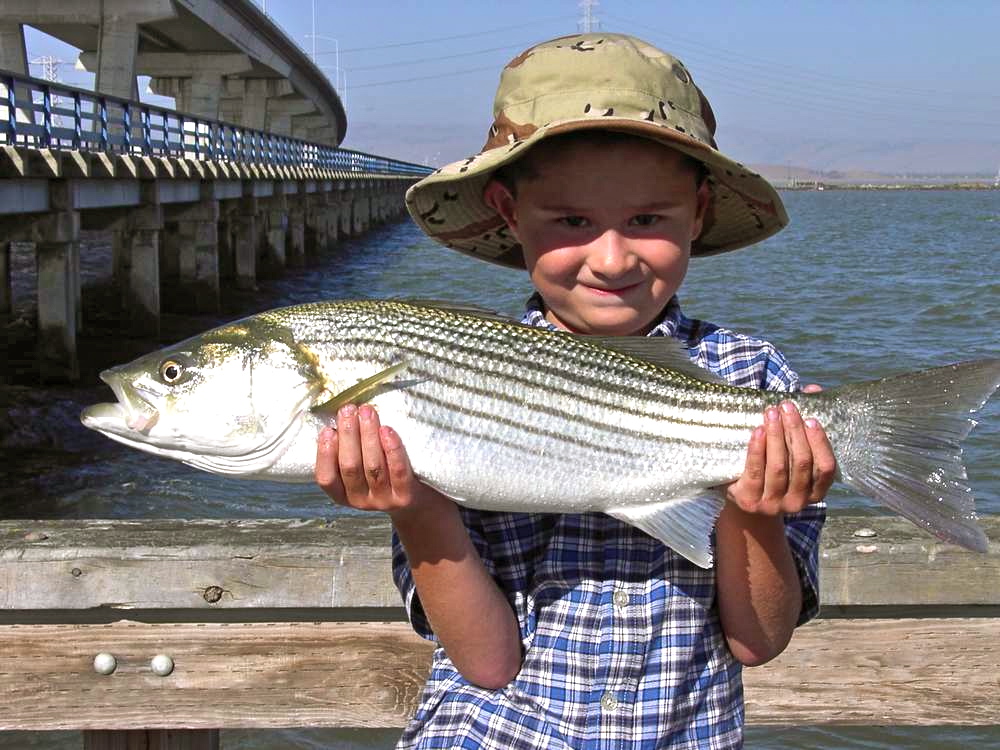
Striper caught by Thomas Orasco at the Dumbarton Pier in 2005
Large recorded but “unofficial” striped bass from piers — and undoubedly many more large bass have been taken
52 Lbs. — San Mateo Pier, mid-80s; Source: PFIC
41 ½ Lbs. — San Francisco Municipal Pier, June 8, 1954; Source: San Rafael Daily Independent, June 9, 1954
40 Lbs. — Dowrelio Pier (Crockett), Amel Ligienghal, March 4, 1962; Source: The Fishin’ Fool, Ralph Stevens, San Rafael Daily Independent, March 6, 1962
34 Lbs. — Marin Rod and Gun Club Pier, Louis Moffdo, September 1975; Source: Fish and Game, Al Giddings, San Rafael Independent Journal, September 12, 1975
34 Lbs. — Marin Rod and Gun Club Pier, May 27, 1959; Source: San Rafael Independent Journal, May 27, 1959
34 Lbs. — Carquinez Bridge Bass Club Pier (Crockett), Jerome L. Thompson, July 1, 1937; Source: Oakland Tribune, July 3, 1937
33 Lbs.— Santa Cruz Wharf, 1996; Source: Santa Cruz Wharf Bait Shop
32 Lbs. 12 oz. — Berkeley Pier, Manuel Gutievrez, April 13, 1959; Source: Line On The Sportsman, Mike Dwyer, Oakland Tribune, April 14, 1959
31 Lbs. — Capitola Wharf, September 1995; Source: Capitola Wharf Bait Shop
30 Lbs. 1 oz. — Berkeley Pier, Shig Akagi, February 25, 1958; Source: Line On The Sportsman, Mike Dwyer, Oakland Tribune, February 26, 1958
30 Lbs. — San Mateo Bridge Pier, Kevin Fiske, June 18, 1973; Source: San Mateo Times, June 20, 1973
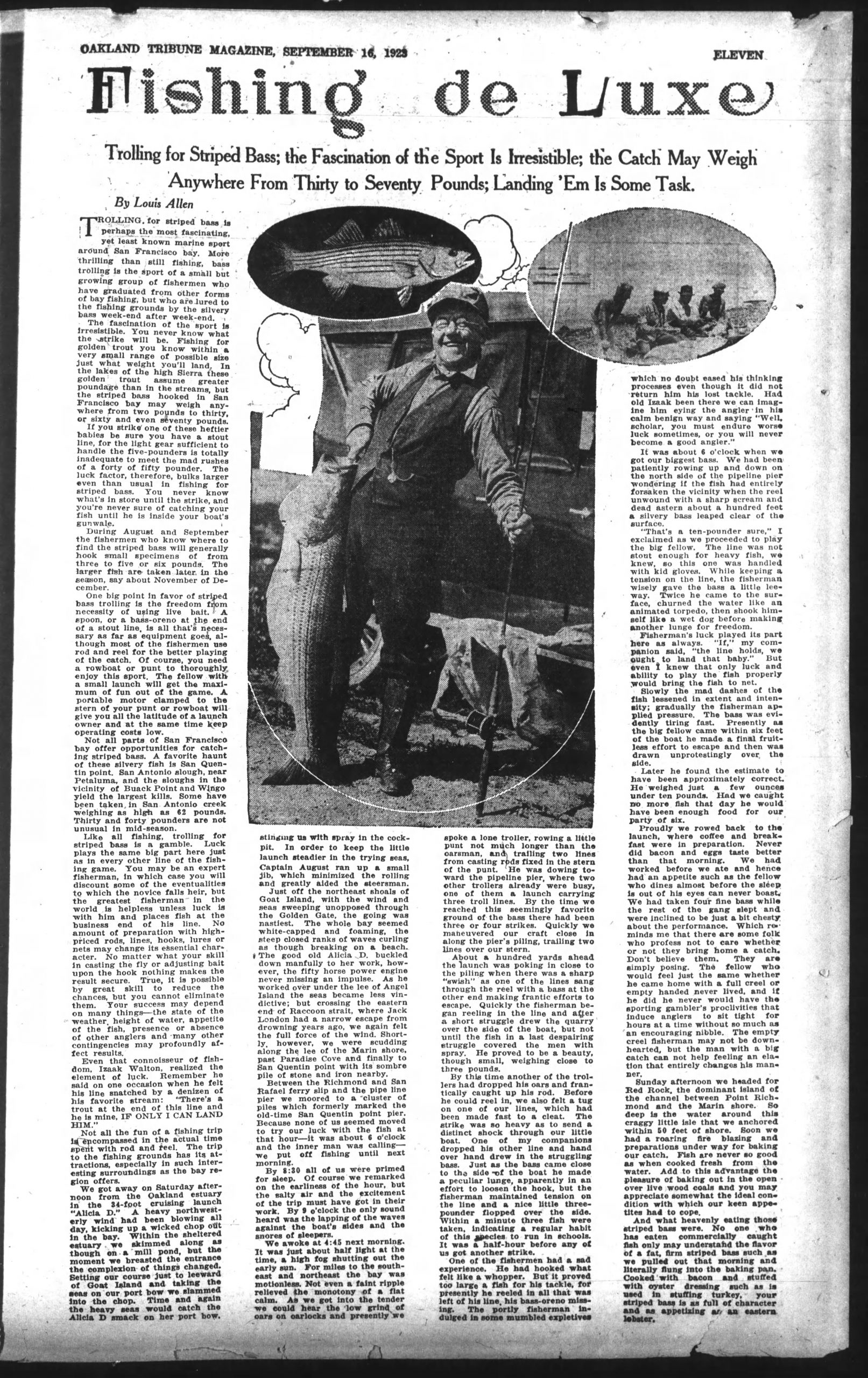
Oakland Tribune article — September 16, 1923
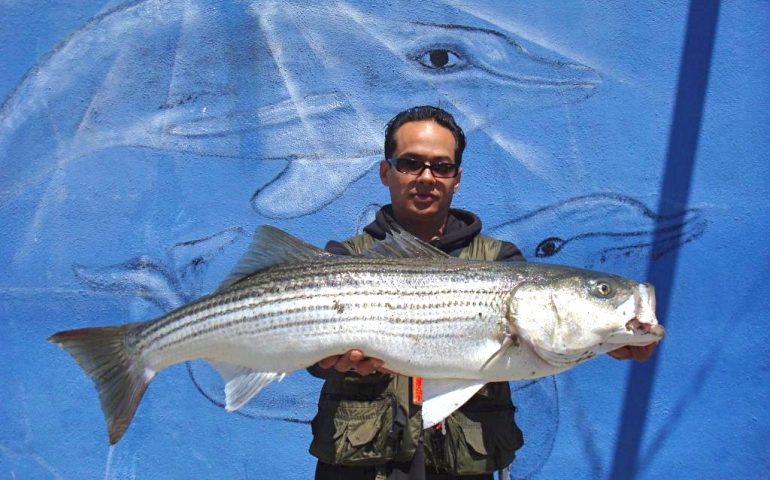
Nicely done layout of in formation for a first time pier fisherman, (now that I am retired).
I think I am going to try Lime Point Pier under the Golden Gate. It would be nice to know where to find live bate on the Marin side ot the Bay.
Very Big a Fish. Nice post
Great Article
Thank you for sharing this data. I really enjoy what you’ve written on your blog. You’ve shared a very useful and entertaining blog post with the public.